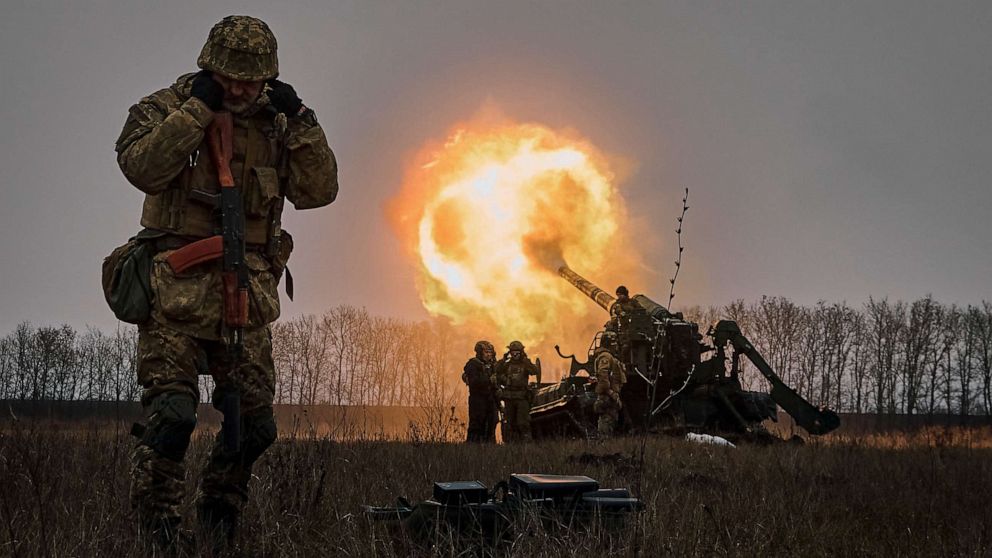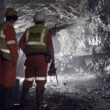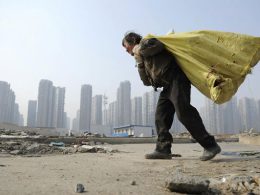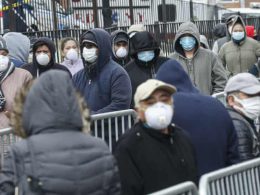By Walter Chambers, International Socialist Alternative
Any end to the war in Ukraine seems as far off as ever while the huge human, social and economic costs continue to mount, not just in Ukraine itself but across the world. In Ukraine, six cities including Mariupol and Severodonetsk with a combined population equal to that of Dublin or Düsseldorf have been wiped out.
Bakhmut, once having a population of over 100,000 has been destroyed. As Russian forces failed to make headway over the winter, they attacked Ukraine’s infrastructure, forcing major cities to restrict power supplies. The destruction of the Kakhovka dam, however it happened, is a direct result of the Russian invasion of Ukraine and is a major human, economic and ecological catastrophe, the results of which will last for years.
Increasingly, military targets and fuel supplies in Russia itself have been targeted. Drones have attacked Moscow and other cities, while there have been troop incursions into towns neighboring Ukraine. The western powers have stepped up arms supplies even further, while China has been promoting its “peace plan”. The major imperialist powers are flexing their muscles as the New Cold War develops.
Catastrophe for Kremlin
After September’s annexation of four Ukrainian regions, the mobilisation of 300,000 troops, and November’s humiliating retreat from Kherson, the Russian regime has made no significant progress. It took a brutal ten-month battle to take Bakhmut at a huge cost in lives for what many military strategists say is only a tactical advantage. As the Ukrainian offensive starts, it could lose control.
Russian forces desperately needed to take Bakhmut to demonstrate at least some success. The battle was led by the notorious “Wagner” mercenary group. Increasingly its leader, Evgeniy Prigozhin has been publicly attacking the army and its leadership. His forces even ended up in a battle with regular forces as they withdrew from the city. Prigozhin published a video with his troops in the nearby salt-mines, he makes no secret that they are plundering those areas they capture. .
Within Russia, every blow dealt by Ukrainian forces provokes angry condemnation of the army leadership, and increasingly of the Kremlin itself by the ‘party of war’. As Putin delivered his New Year message, supported by actors dressed as soldiers, dozens of newly mobilised troops watching in a hall on the edge of Donetsk city were killed by a HIMARS missile, aimed using signals from their mobile phones. Many officers escaped — their party was in a more luxurious location.
Much, although confused, anger at the incompetence of the military command mixed with demands for revenge was expressed at their funerals. At the same time, others asked why Ukraine had been attacked, “Russia”, they said “had too many of its own problems”. Elsewhere, parents protested outside a school against a memorial plaque to a convicted murderer who died as a Wagner mercenary, when there was no money to repair the school toilet.
Russian economy
In 2022, Russian GDP fell by 2.1%. The wide range of forecasts for GDP in 2023 from the OECD’s 5.6% drop to the Russian Central Bank’s 1% growth in reality, reflects big and chaotic changes within the Russian economy, which make it difficult to map the real situation. But recent more optimistic forecasts hide the fact that for working people, the war and its consequences are doing real damage.
Officially inflation in 2022 was 12%, but much higher for essential goods with some staple foodstuffs 30–50% more expensive. Even during the war, the wealth of the richest Russians has grown dramatically. The nominal incomes of business and entrepreneurs grew by 26%, whilst those who rely on wages and pensions saw only 12% increases. For the latter, real disposable incomes fell by 6%, following a steady fall each year since 2008. Forbes names ‘Russia and Central Asia’ the region in the world with the highest share of national wealth (45.9%) owned by the top 1%.
This would be bad enough in normal times, but these are not normal times. The Russo-Georgian war in 2008 followed ten years of economic growth, when there was still relative global cooperation. Russia contributed over $200 billion to the economic stimuli following the Great Recession of 2008/9. But then, the momentum of the globalisation process stalled, and Russia experienced mild sanctions after the 2014 takeover of Crimea. Foreign Direct Investment in Russia reached its peak of $75 billion in 2008 and a smaller peak in 2013 of $69 billion, but has since averaged $22 billion a year.
In 2022, FDI flow was negative as western companies, mainly well-known brands with large workforces and low profitability, disinvested. Actually, only 18% of US, 15% of Japanese and 8% of EU subsidiaries have completely withdrawn, but some key industrial sectors have been badly hit. New car sales fell by 80% in 2022. The gap left by the departure of Toyota, Ford, Volkswagen is being filled by more basic Russian or Iranian models. The former BMW and Nissan plants are negotiating contracts with Chinese makers.
Nevertheless, industrial output in 2022 increased slightly, as production was stepped up to replace western products and, importantly, weaponry. Arms factories have been instructed to work three shifts to produce tanks, artillery, drones, and other deadly weaponry. Notwithstanding corruption and inefficiency, by the time the first hundred western tanks arrive in Ukraine, twice as many new Russian tanks will have been built, and another 300 repaired or modernised.
The backward state of technology means that Russian cars and weapons systems depend on western or Chinese produced chips in their control modules. When production of the new “Moskvich” car started in Renault’s former factory, chips needed for the airbags and modern braking systems were missing. To by-pass sanctions, a complex system of “parallel imports”, purchasing parts through third countries such as Turkey and Hong Kong is used. Now the government is earmarking $40 billion to modernise the Russian chip industry to produce 28 nm chips by 2030. Taiwan reached that level in 2011 and by 2030 will have reached 2 nm. [Crudely put nm refers to the size of the transistors on the chip, the smaller the size, the more powerful the chip.]
Oil always finds a buyer
Western sanctions on Russia’s oil and gas exports have, so far, been spectacularly unsuccessful. EU restrictions on oil imports have been compensated by an increase in sales to other countries, although at a large discount. India, which tries to maintain a balance between the two main powers, has increased the proportion of oil it imports from Russia from a pre-war 2% to almost 50%. As one commentator put it: “Oil sellers quip oil always finds a buyer”.
A 20% drop in LNG exports from Russia was compensated by a doubling of average prices. Russian budget revenues from hydrocarbon exports in 2022 increased by 28%. From 2008–2020 Russia’s monthly income from the sale of hydrocarbons averaged $18 billion, since the war started it has exceeded $25 billion. Its trade balance increased by $58 billion dollars in 2022 — up by 25%. Statistics for the first part of 2023 show so far a 20% increase on comparable months in the pre-war 2021.
Nevertheless, the Russian economy faces several difficult years, particularly for the working class, which lacks organisation and in a situation in which it is difficult to resist the regime. Consequently, almost all protests have a large degree of spontaneity. During the pandemic, restrictions to control the disease were used to tighten the screws. With the war, repression has become a way of life.
Even though over 20,000 people were arrested in 2022, protests over a whole number of issues have continued. 400 workplace disputes were reported, with 72 developing into strikes or sit-down protests. Although less than in 2020, when many companies failed to pay workers during the pandemic, now the stakes are higher. Strike leaders such as Kirill Ukraintsev, of the couriers’ union spent over a year in prison. Elsewhere workers who warn they will stop work are threatened with mobilisation into the army.
Anti-war protests took on a new form after mobilisation, as war began to affect a much wider layer of the population, especially now that “Freight 200”, the military codeword for dead soldiers, is increasing. Significantly, of the over 25,000 fatalities identified by independent researchers, which they themselves say is an underestimate, the proportion from the non-Russian regions such as Buryatia and Dagestan, or cities further to the east and south are over ten times higher than in Moscow and St Petersburg. This fuels discontent and the national question. However, without a clear focus, consciousness can be confused and contradictory.
Significantly though, protests are becoming more feminine. In January 2021, the percentage of women participating in protests was 25%. In the early anti-war demonstrations, it was 44%. After mobilisation an even more dramatic rise to 71% was seen. As many men have been mobilised or fled the country, in the workplaces women will become more assertive in demanding rights.
Crisis in the Kremlin?
After the Russian offensive stalled early in the year, the hardliners — Ramzan Kadyrov, Head of Chechnya, Wagner’s Yevgeniy Prigozhin, and General “Armageddon” Surovkin, were sidelined as overall control of the invasion was returned to the official military hierarchy led by Defence Minister Sergey Shoigu, and General Gerasimov.
But the mass missile attacks on Ukraine’s infrastructure initially pushed by the hardliners continued. This cruel tactic “succeeded” in causing severe disruption and hardship to working-class and poor Ukrainians, but failed to decisively turn the tide. Ukraine’s air defences, using Soviet designed S300 missiles, anti-aircraft guns and drones, and western systems which started to arrive at year-end, destroyed a large proportion of missiles fired. Even so, many hit their targets — one substation supplying Kyiv has been hit nine times. Repair workers work 24/7, ignoring previous management bureaucracy to ensure speedy repairs, often arriving at damaged sites before the fires had even been put out. Kyiv residents describe workers on the “energy front” as “heroes to us all”. Every time the Russian regime feels weakness, it steps up its missile attacks on civilian areas.
Tension between the hardliners and official military leadership has been dramatic. Prigozhin and Kadyrov have increasingly accused the military bureaucracy of incompetence and corruption. Prigozhin describes the army’s failure to provide him with ammunition as “treason”. Increasingly the Kremlin appeared to grow tired of Prigozhin’s criticisms, and possibly in fear of the danger he poses, has attempted first to sideline him, and then to bring him under control. As Wagner troops advanced on Bakhmut, the Russian media was instructed not to report it. Now new mercenary armies in opposition to Wagner including some run by the large corporations such as GasProm are being formed. In the recent period conflicts have emerged between Wagner and other hardliners such as Kadyrev and the former KGB/far-right mercenary Girkin who seem to resent Prigozhin’s dominance.
Can this eventually lead to a political, even revolutionary crisis in Russia? Lenin explained a revolutionary situation could develop if the ruling class is split and unable to rule in the old way, the working class no longer tolerate the old conditions, and the middle layers are in ferment. This, he said, if led by a mass and authoritative revolutionary party to arm the movement with the correct strategy and tactics could lead to a successful revolution.
The potential for working class protest, including those who have been ‘mobilised’ is clear. Many who participated in the two remarkable waves of protest in 2022 were working class youth and relatives of the mobilised, but so far wider layers of the working class have not been involved in an organised way, nor on a mass scale.
The middle class layers though are certainly in ferment. Amongst the hundreds of thousands who have fled Russia are many TV personalities, musicians, artists, and liberal figures such as the architect of mass privatisation, Anatoly Chubais. The main state TV channel uses podcasts to fill prime time broadcasting as so many of its “stars” have left.
Capitalist restoration has not created a strong, consolidated bourgeois class able to maintain stability. It relies on authoritarian measures and a bonapartist state, with power concentrated in the hands of one person. The few oligarchs who have opposed the regime have been imprisoned or forced into exile. As Russian capitalism’s reactionary, imperialist, expansionist appetite has grown, significantly most oligarchs and their hangers-on largely welcomed the invasion of Ukraine. The few who were not happy were only defending their own assets.
The Kremlin’s private polling shows a relatively small layer of hard-line supporters of the war. The majority of Russians want a quick end to the war, if necessary through negotiations. But currently, it is the outspoken hardliners who dominate state and social media.
The ruling elite though is cowardly. Supposedly, a layer within the ruling elite would rather see negotiations, but are paralysed by the fear they will become victims of repression. They see no easy way out. Various reports indicate that it believes that Russia is facing a humiliating defeat. Even if Donbas and part of south Ukraine remain under Russian occupation, which the regime would portray as victory, the tremendous human and economic cost may not be seen as justified by large sections of the population. Initially, the ruling elite hoped that somehow the Kremlin had a plan. But now they fear a defeat, which they understand could well lead to a social explosion that none of them wish to see. There have been many suicides or unexplained deaths from within the regime, the latest, being Deputy Minister Pyotr Kucherenko, who had described the invasion of Ukraine as “fascist”.
This reality set in after the retreat from Kherson. But no section of the elite is currently suggesting ending the war, possibly retreating back to February’s borders, for fear of repression by the Bonapartist regime and also of provoking social protest. They can only hope for more delays in the war, to allow the army to re-equip, the economy to recover, and to mobilize new forces, avoiding any measures that risk a more open conflict with NATO forces. Paradoxically, some hard-liners also push this line, understanding any further escalation would lead to catastrophe.
Other hawks such as the reactionary ‘Communist’ Party still argue the only way out is to step up the attacks, maybe even openly declaring war, with full-scale mobilization and widespread bombing of Ukraine as expressed by their leader Zyuganov: “From the first day of the ‘special operation’ we have demanded emergency measures… to allow for the maximum mobilisation of the whole of society in the fight against nazism and fascism…”.
Either the war will drag out with terrible costs, leading to increased domestic opposition, or ham-fisted attempts to escalate could lead to new sudden defeats and a more explosive opposition.
An even more worrying perspective for the ruling elite is that set-backs, or a ‘black swan event’ (unexpected or unpredictable event) could lead to a spontaneous explosion from below — as happened recently in Belarus, just a year ago in Kazakhstan, or in March, which led to protests and rioting in Georgia. That could provoke a section of the ruling elite to break ranks with the Kremlin in an attempt to divert such a movement. They could be helped by a section of the liberal opposition, as there are signs of splits appearing in Navalny’s organisation, with a section possibly attempting to link up with key oligarchs.
The central problem is the lack of an independent working-class force that can give direction to potentially explosive protests against the Kremlin, and the capitalist system that created the dictatorial regime in Russia. That there is not an independent working-class movement now does not mean that one or the beginnings of one could not be brought into being in the course of the undoubtedly tumultuous events that will take place in the region in the months and years ahead. Clearly forging the first steps in creating such a movement, and arming it with a clear socialist programme has to be the main task of socialists in Russia today.
Huge costs to Ukraine
Untold damage has been done to Ukraine. The Ukrainian Defence Ministry does not report fatality numbers, but they are terribly high, particularly around the “meat-grinder” of Bakhmut. In September, Prime Minister Denys Shmyhal estimated the cost of damage at over $349 billion. Since then, at least another $120 billion damage has been done to the infrastructure. In October Volodymyr Zelensky said that Ukraine needed at least $1 trillion to “rebuild to EU standards”. The total aid committed so far is nowhere close to this.
This war cannot be understood in isolation from the international situation, which is dominated and characterised by the developing New Cold War, forcing the realignment of imperialist blocs and alliances around the US-China axis, a process dramatically speeded up by the war in Ukraine.
The often misquoted Carl von Clausewitz stressed the dialectical interaction of diverse factors: “War” he said “is the continuation of political intercourse with the addition of other means”. Its outcome depends not just on military decisions, but on social-political phenomena, and on the relation between the regular army, partisans, and the general population. This war is no different.
While the war is part of the wider New Cold War the Russian regime’s claim it is just fighting NATO and US imperialism is wrong. Opponents are condemned as agents of the “Anglo-Sax” world. If the majority of the Russian population was convinced this was so, and that Russia was under threat of imminent invasion, then Russian forces would be massively motivated to fight. But instead, Russian imperialism with its superficially powerful armed forces and weaponry has ended up with its forces demoralised, undermined by corruption and bad planning, and with constant conflicts between the different wings — the regular army, national guard, FSB and Wagner mercenaries — misled by an authoritarian and isolated leadership in the Kremlin.
Western imperialism, for its part, originally underestimated the resistance of Ukrainians, then did everything possible to diminish initiatives from below. It has seized the opportunity to massively increase military expenditure, to lever potential partners into a more consolidated anti-China, anti-Russia block, to warn China not to invade Taiwan. Still reluctant to allow Ukraine full membership either of the EU or NATO, it has used aid and the delivery of weapons to support its own aims, and impose its own conditions on Ukraine.
The Ukrainian population has completely different motivations to NATO and the right-wing Zelensky government. Clausewitz said that forces defending themselves against aggression are inherently superior. In Ukraine today, with the country, homes, livelihoods, and freedoms under threat by the Russian occupation, there are many examples of heroic resistance. This often contradict the agenda of both Russian and Western media, which wants to paint the conflict as simply one between two military forces, and weaponry.
On the night of 24 February 2022 as thousands of Russian troops were advancing on Kyiv, residents turned out to build, at first make-shift, barricades. As Zelensky announced mass mobilisation, volunteers flocked into ‘territorial defence units’ arming themselves with whatever they could find, setting up checkpoints and preparing resistance. Tank columns approaching Kyiv were ambushed at every stage by volunteer and regular army groups. They climbed telegraph poles to monitor the telephones of the approaching troops. Even at this early stage, many ordinary Ukrainians learnt the use of drones — often purchasing them online for a few hundred dollars — to observe, and even drop grenades on the advancing tanks. Front-line workers — the same who sacrificed so much during the pandemic stepped up — medical workers, railway crews who transported equipment and refugees, lorry drivers who delivered concrete bollards, and helped supply those fighting.
The army, police and local authorities abandoned Sumy, the main city between Kyiv and Kharkiv, in the early days of the invasion. According to a report, city council workers mobilised a territorial defence squad of several hundred civilians. Without body armour, arming themselves with rifles from a local army store and Molotov cocktails, using mobile telephones and messengers, they held the invaders off for over six weeks, before Russian forces were forced to flee from the region.
Such initiatives taken by ordinary working people to defend their homes and livelihoods are numerous. Medical staff at a hospital in Kherson prevented a Russian takeover using a number of tricks, including the declaration of a pandemic quarantine. Workers in factories and small workshops adapt shop-bought drones for intelligence gathering and targeting. Others are repairing captured Russian tanks and equipment. Ukraine has obtained many battle tanks in this way.
Popular initiatives, particularly if led by an organised and politically conscious working class could have changed the course of the war. But as the army, and western weaponry have played an increasing role, such activities have been pushed aside. As the war has dragged on and more and more heavy weaponry is employed, the battles have become brutal conflicts. Leon Trotsky argued, when analysing wars in the 1930s, that weaker nations facing superior military forces cannot win against imperial occupation by military means alone. History has demonstrated this on many occasions. The mass mobilisation of the population always proves far more inventive than the professional army corps. And bourgeois forces, even though claiming to represent the “whole nation” are not capable of doing this. On the contrary, the bourgeois, particularly if they lean for support on imperialist powers, will do all possible to prevent such mobilisation, as it leads to a rise in working class consciousness and a direct challenge to their rule.
Instead of independent action by the masses, under working class leadership, the Ukrainian leadership is relying on brutal military action, using more and more powerful weapons. Tanks are now promised by NATO countries. On 24 April the US Defence Ministry reported the 31 promised Abrams tanks will reach the front by year-end. Forbes reports the Leopard 1 tanks promised by Germany and Denmark will probably arrive in time to help “mop up” after Ukraine’s expected offensive. But even NATO promises provoke Russia to respond — now it is sending the newest T14 tank even in small numbers to boost the morale of Russian forces. This, and the use of more fighter aircraft by both sides, will not speed the end of the war, but increase the fatality rates on both sides. This deadlock cannot be broken militarily without horrific new losses of human life.
ISA is absolutely opposed to the brutal invasion of Ukraine by Russia, and demands that all Russian forces should be withdrawn from Ukraine so that Ukrainians themselves can decide their own future without military occupation. We also oppose the transfer of weapons by the western imperialists, which they do not to defend the Ukrainian population, but in their own imperialist interests.
The only force capable of providing the political motivation to ensure the removal of Russian troops from Ukraine, and guaranteeing not just its self-determination, but also the rights of national minorities and groups within Ukraine is the organized working class, completely independent of any imperialist and capitalist forces. ISA stands for the building of such a force, linked to a struggle to transform the lives of working class people throughout Ukraine, to bring down the Zelensky government, expropriate the Ukrainian and Russian oligarchs, and establish a workers’ government to implement socialist policies.
Ukrainian workers under attack
The Zelensky government is, however, through its actions attacking and undermining the strength of the working class. The right to strike has been removed, and a large number of companies have been earmarked for privatisation. The new budget for 2023 reduces the wage pool for those working in the public sector by 23% by making huge numbers unemployed. This is against the background of nearly 30% unemployment, and inflation at over 20%.
Western governments boast of the support they give to Ukraine, but stay silent about the conditions. Of the 60 billion euros financial aid so far promised, half is in the form of loans to be repaid over the next 35 years. The rest is grants tied to strict conditions including ‘restructuring’, increasing labour productivity and the sale of energy at market prices.
The recent purge of government figures was to cut across growing discontent at profiteering and corruption. Food purchased for troops cost three times more than in city supermarkets. Vehicles donated as ‘humanitarian aid’ were used by government officials. One Minister allegedly stole $400,000 intended for infrastructure reconstruction. The latest arrests of regional leaders, including the Mayor of Odessa who is accused of setting up a criminal gang and money laundering, also appears to be aimed at heading off attempts by regional heads to strengthen political opposition to the centre. The possible postponement of this year’s parliamentary election carries dangers of further moves in a bonapartist direction.
Is there a possible end to this war?
During a flurry of discussions about possible negotiations last Autumn it was clear that Zelensky and Ukraine would not agree to any negotiated agreement that left Russian forces occupying any part of the country. The Kremlin spoke of possible negotiations without being prepared to make any concessions — in reality, wanting a period to rebuild their forces.
After the attacks on Ukraine’s electricity infrastructure failed to bring it to its knees, and the brutal offensive by Russian forces in Donbas failed to make any significant gains, it is not clear how the war will develop further. The offensive by Ukrainian forces will probably aim to return the so-called land-bridge between Mariupol and Kherson occupied after 24 February to Ukrainian control. To take back that part of Donbas controlled by pro-Russian forces since 2014 would devour many human resources and much equipment.
The G7 summit in May in Hiroshima, with Zelensky as invited guest has again demonstrated how far US imperialism has succeeded in strengthening the Western block, with promises of continued support for Ukraine and a unified condemnation of Chinese “economic coercion”. Whilst political unity on these issues is clear, there are still differences though on how to deal with the issues. According to the Japanese News Agency “Kyodo News”, the resistance of French President Macron to plans to open a NATO office in Japan, which he believes will provoke China “has complicated months of discussion within NATO over the opening of the outpost in Tokyo.”
Confirming that US support for Ukraine is driven by its own objectives, its need to strengthen its position in the developing inter-imperialist conflicts, paradoxically some of the more “dovish” voices in the US establishment are found in the military compared to political “hawks”. Chair of the US’s joint chief of staff Mark Milley has repeatedly said that the war will eventually end in negotiations.
In a flurry of statements around Biden’s visit to Kyiv in late February, senior US officials demonstrated ‘strategic ambiguity” over Crimea. Biden promised full support to Kyiv, but did not publicly endorse its aim of taking Crimea back. Under Secretary of State Victoria Nuland, said “Russia has turned Crimea into a massive military installation…those are legitimate targets, Ukraine is hitting them, and we are supporting that”. Any attempt by Ukraine to take Crimea would mean crossing one of Russia’s “Red lines” warned Secretary of State Antony Blinken, “that could lead to Russia widening the war”. The “Washington Post” meanwhile reported that “U.S. officials have warned Kyiv that present levels of U.S. aid to Ukraine cannot be guaranteed, and that Ukrainian ambitions may have to be modified”.
It is typical of the cynicism of the imperialists of both sides that the fate of Crimea, and its population, is only based on its military significance, and whether it can be traded during negotiations. Like Ukraine itself and all regions and communities within its borders, Crimea has the right to self-determination, which is only possible to determine in conditions of no military occupation by either side. For this it is necessary that the working class of Crimea is organized, to oversee a genuinely democratic vote, ensuring the rights of the Ukrainian and Tatar minorities are protected, and by taking the resources out of the hands of the Russian and Ukrainian oligarchs to use in the interests of working people and the poor.
It is clear that in the future at some time the potential exists for tension between the US aim of seeing Russia forced to retreat, thus weakening it as a partner for China and the stated aims of the Kyiv government to retake the whole of the territory it has lost since 2014 to develop. This was demonstrated by the pressure put on Zelensky to withdraw from Bakhmut by Biden’s officials in January. At this stage, the US is supporting a new offensive by Ukraine to take back the land-bridge as the next step. This however is not likely to satisfy the Ukrainian government in the long term.
The opinion poll [published 24.02.2023] in the non-occupied regions of Ukraine show that the mood of the Ukrainian population hardened over the winter. If before, very few supported attacking Russia itself, now 38% think that military targets in Russia should be attacked, another 39% think that infrastructure objects too should be targeted. A further 13% think that any target in Russia is now valid. This includes an overall majority of those in the South and East who consider themselves ethnic Russians or who have close relatives in Russia.
Another factor pointing to a potential contradiction between US and Ukrainian aims is the fear in NATO circles at the cost and consequences of long-term support for a drawn out war, which is also being reflected in discussions within the US and EU ruling elites, and within the US Republican party on the issue. The last reliable report of assistance committed to Ukraine was by the Kiel Institute for the World Economy in February 2023 when it reported a total of 143 billion euros. KIWE is, of course, pushing for more support for Ukraine when it says that only 48% of the then promised financial aid and about 25% of military aid had been disbursed.
KIWE points to what it calls the bigger picture. Long drawn-out wars consume huge resources, particularly if troops on the ground need financing. Annual US military expenditure on the Vietnam and Korean wars — where US troops themselves did the fighting — as a percentage of GDP was 5 and 13 times higher respectively than even the huge amounts committed already to Ukraine. While the EU alone has promised Ukraine 55 billion euros, it has mobilized 10 times more in domestic energy support packages. The danger of costs ballooning even further, at a time when there are so many other demands on the world economy, as well as growing pressure from right wing republicans in the US will fuel the “war-fatigue” that is already being discussed in some ruling circles.
China in its turn has stepped forward with its “position paper” on the war published in February, which contains 12 points, including the recognition of national sovereignty of both countries, an end to military actions, the renewal of peace talks, an end to one-sided sanctions and post-conflict reconstruction. Other figures have already started to push for negotiations. A delegation of African leaders led by Cyril Ramaphosa is visiting Moscow and Kyiv.
Biden called the idea that China could lead negotiations “just not rational”. Not only would this undermine US determination to build its alliances and military potential ready to challenge China, there is also concern that China is aiming its initiative to build support with other countries not directly part of the Western block. According to “the Japan Times”: “Few expect Chinese President Xi Jinping’s diplomacy to yield breakthroughs on the Ukraine war. But in Washington, there are fears Beijing may succeed elsewhere — winning credibility on the world stage.”
The limits of the “No limits” deal with China
It is clear that when Putin launched his invasion, he felt that China, which had just agreed its “No limits” partnership was prepared to support him all the way. If the war had indeed been successful, China would have seen Russia as a strong and successful partner. But now it sees that Putin’s lack of success, combined with the huge strengthening of the US-Western block that has resulted has undermined Russia’s potential as a partner. For this reason, Xi Jinping is seeking a way of lessening the negative consequences. In this way his peace plan, in contradiction to the claims of western leaders, is not intended to support Russia whatever it does, but to protect the interests of the Chinese regime.
Xi Jinping and Vladimir Putin in the Kremlin
The peace plan dominated the discussions during Xi Jinping’s visit to Moscow in March. Initially, at least in diplomatic speak, it met with approval in the Kremlin, although it was clear from reports in the Russian press that behind the scenes Xi was putting pressure on Putin.
Economic agreements were signed as part of the strategy first agreed in 2019 to expand bilateral trade to $200 bill a year by 2024, a target that could well be exceeded this year in large part because the “Siberia 1” pipeline has reached full capacity combined with increased energy prices. Agathe Demarais of the Economist Intelligence Unit suggests however that “It is likely that Russia’s energy exports to China have now reached a plateau after booming last year. Beijing is careful not to become overly dependent on a single energy supplier.” During his visit to Moscow, Xi refused to sign off on the “Power of Siberia 2” gas pipeline which would have allowed China to purchase more gas from Russia, arguing it does not: “desire to increase its dependence on Russian suppliers”. It is instead pushing ahead with a new pipeline to Turkmenistan.
A follow up visit by Russian Prime Minister Mishustin to Beijing was, according to the Russian business paper “Vedemosti”, noted for the way in which the Chinese showed no interest in providing even any real economic assistance. Following the visit, the Bank of China has informed several Russian banks that it will no longer process international transactions from Russia.
Clearly the Kremlin is feeling the pressure. After Xi followed up his visit to Moscow with a phone call to Zelensky at the end of April, and then China, India and Brazil all changed previous voting patterns to support a UN resolution which included the phrase “aggression by the Russian Federation against Ukraine”, Russian state TV complained of betrayal: “Comrade Xi Jinping, why did you come to Moscow? And spend three days here, interrupting Putin’s work?”
Zelensky described the call with Xi Jinping as “a strong stimulus for the development of interstate relations”. He is, he said, open to parts of China’s plan, if it meant Russia withdrawing from all occupied territory. Ukraine is, according to Xi, a “strategic partner” of China, which as a country is the largest trading partner of Ukraine. Zelensky agreed to send an Ambassador to China, and China has sent diplomats to Kyiv to work on the peace plan.
The US is expressing its anger at the apparent willingness of certain European leaders, led by France’s Macron, to encourage China’s moves. Germany’s Sholtz, Spain’s Sanchez and others have also visited Peking and Italy’s Meloni is planning to go. China wants to drive a wedge between the EU and US, and Macron is concerned that the EU is too subservient to the White House. He has said he wants to work with China to develop a proposal.
The way in which China is putting pressure on the Kremlin, as well as the actions of different European governments countries demonstrate that while there is a clear dynamic towards the polarisation of the world into two imperialist blocks, that has been accelerated by the war and will continue, there are significant tensions within blocks as governments become concerned that their own economic and geopolitical interests are being harmed.
The discussions around the Chinese plan suggest that some form of “security guarantee” for Ukraine provided by France, Germany and China could be considered as an outline for a potential deal in the future.
It is however far too early to envisage a negotiated settlement at this stage. If the Ukrainian offensive to take the land bridge succeeds quickly with a rout of the Russian forces, the Kremlin may then be panicked into talks, but the Ukrainian population may still not accept the annexations of Donbas and Crimea. If the offensive however drags on for many months, war weariness may develop both in Ukraine itself, and amongst Zelensky’s western backers. Then a mood for negotiations may develop.
But experience from 2014–22, and in many other countries demonstrates that negotiated settlements organised by the imperialist powers will not lead to any long-term solution. From the very first day of the war, ISA has opposed the war, defended the right for Ukrainians to decide and defend their own future. We demand the immediate withdrawal of Russian troops from Ukraine, Western imperialist troops from Eastern Europe and the dissolution of all military blocks such as NATO. However, even if Ukraine succeeds in achieving its military aims, and forcing all Russian troops out of Ukraine that too, on the basis of the current capitalist systems and the escalating New Cold War will not provide a long-lasting, stable and peaceful guarantee for Ukrainian independence.
As ISA said in its statement 24.02.2022: “We cannot rely on any of the imperialist institutions or war machines involved to create peace, let alone prosperity… We should have no trust in these imperialist bodies. Any ‘diplomatic solution’ agreed between them, while it would be welcomed initially by people worldwide, will ultimately be at the expense of ordinary people and only prepare the ground for further tensions and confrontations.
This makes it even more important that socialists and the working class in Ukraine, in Russia, and across the world build mass campaigns to build strong alternatives to the imperialist and capitalist governments wherever they exist, and based on strong, international working class solidarity to overthrow the capitalist system that causes war, poverty, climate change and national oppression, and its replacement by world-wide federation of genuinely democratic, socialist states.












